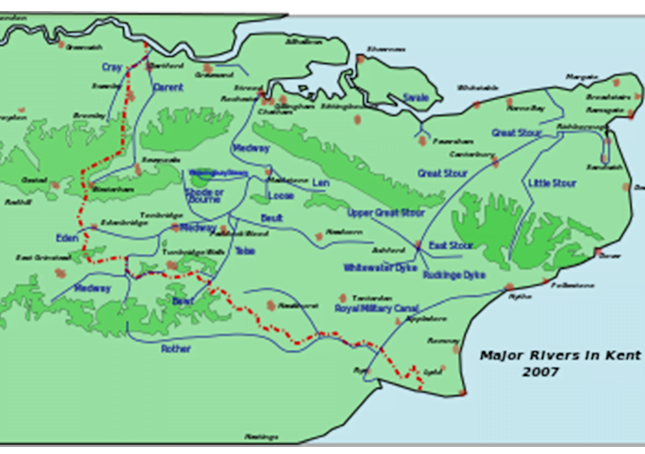River Len

The River Len is a river in Kent, England. It rises at a spring in Bluebell Woods[1] to the southeast of the village centre of Lenham 0.6 miles (0.97 km) from the source of the River Great Stour; both rise on the Greensand Ridge. Its length is c10 miles (16 km). It enters the River Medway at Maidstone.
The river flows in a generally westerly direction. Today it runs parallel with the M20 motorway for much of the first part of its journey: it passes between the hamlet of Fairbourne Heath and Harrietsham; after Broomfield the river becomes the lake adjoining Leeds Castle. The Len enters the town of Maidstone south of Bearsted and its waters become the lake in Mote Park; and it enters the River Medway c1.25 miles (2.01 km) beyond.
The river powered a number of watermills on itself and its tributaries in the parishes of Ulcombe, Leeds, Hollingbourne, Boxley and Maidstone.
TQ 861 523 51°14′22″N 0°40′01″E
A Domesday site, Holme Mill is recorded as Holemiln in 1254 and Holemille in 1332. In 1542 the manor of Polhill was in the ownership of John Stede. The mill passed to his son Thomas and then to his son Matthew.
The mill was owned by Francis Colepeper Esq at the time of his death in 1590. It was worth 40s per annum then. In 1668 the mill was held by John Ruffen. It was then a fulling mill. Peter Theobalds was the tenant at the time of his death in 1690.
About this time the mill was converted to a corn mill. Stephen Weeks was the miller from 1700–1726, followed by his son John. He was followed by his son Thomas. Thomas Knight leased the mill for 21 years from 1779.
He was followed by George Cronk and then John Brazier and Thomas Martin, who was the miller in 1824. In 1847 John Bunger was the miller, followed by William and Thomas Taylor in 1855. In 1895, the mill was in the occupation of Miller Bros, followed by Mrs Rhoda Vinson from 1907 – 1913. The mill had collapsed by the time Coles Finch visited it and was demolished in 1929, although the waterwheel and pentrough by Weeks of Maidstone survive.
